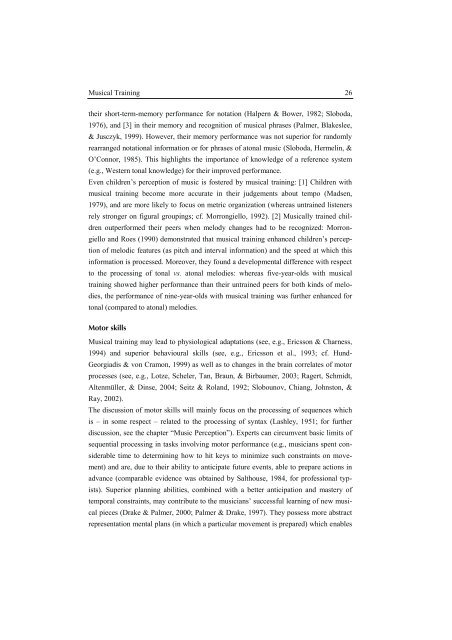Neural Correlates of Processing Syntax in Music and ... - PubMan
Neural Correlates of Processing Syntax in Music and ... - PubMan
Neural Correlates of Processing Syntax in Music and ... - PubMan
You also want an ePaper? Increase the reach of your titles
YUMPU automatically turns print PDFs into web optimized ePapers that Google loves.
<strong>Music</strong>al Tra<strong>in</strong><strong>in</strong>g 26<br />
their short-term-memory performance for notation (Halpern & Bower, 1982; Sloboda,<br />
1976), <strong>and</strong> [3] <strong>in</strong> their memory <strong>and</strong> recognition <strong>of</strong> musical phrases (Palmer, Blakeslee,<br />
& Jusczyk, 1999). However, their memory performance was not superior for r<strong>and</strong>omly<br />
rearranged notational <strong>in</strong>formation or for phrases <strong>of</strong> atonal music (Sloboda, Hermel<strong>in</strong>, &<br />
O’Connor, 1985). This highlights the importance <strong>of</strong> knowledge <strong>of</strong> a reference system<br />
(e.g., Western tonal knowledge) for their improved performance.<br />
Even children’s perception <strong>of</strong> music is fostered by musical tra<strong>in</strong><strong>in</strong>g: [1] Children with<br />
musical tra<strong>in</strong><strong>in</strong>g become more accurate <strong>in</strong> their judgements about tempo (Madsen,<br />
1979), <strong>and</strong> are more likely to focus on metric organization (whereas untra<strong>in</strong>ed listeners<br />
rely stronger on figural group<strong>in</strong>gs; cf. Morrongiello, 1992). [2] <strong>Music</strong>ally tra<strong>in</strong>ed children<br />
outperformed their peers when melody changes had to be recognized: Morrongiello<br />
<strong>and</strong> Roes (1990) demonstrated that musical tra<strong>in</strong><strong>in</strong>g enhanced children’s perception<br />
<strong>of</strong> melodic features (as pitch <strong>and</strong> <strong>in</strong>terval <strong>in</strong>formation) <strong>and</strong> the speed at which this<br />
<strong>in</strong>formation is processed. Moreover, they found a developmental difference with respect<br />
to the process<strong>in</strong>g <strong>of</strong> tonal vs. atonal melodies: whereas five-year-olds with musical<br />
tra<strong>in</strong><strong>in</strong>g showed higher performance than their untra<strong>in</strong>ed peers for both k<strong>in</strong>ds <strong>of</strong> melodies,<br />
the performance <strong>of</strong> n<strong>in</strong>e-year-olds with musical tra<strong>in</strong><strong>in</strong>g was further enhanced for<br />
tonal (compared to atonal) melodies.<br />
Motor skills<br />
<strong>Music</strong>al tra<strong>in</strong><strong>in</strong>g may lead to physiological adaptations (see, e.g., Ericsson & Charness,<br />
1994) <strong>and</strong> superior behavioural skills (see, e.g., Ericsson et al., 1993; cf. Hund-<br />
Georgiadis & von Cramon, 1999) as well as to changes <strong>in</strong> the bra<strong>in</strong> correlates <strong>of</strong> motor<br />
processes (see, e.g., Lotze, Scheler, Tan, Braun, & Birbaumer, 2003; Ragert, Schmidt,<br />
Altenmüller, & D<strong>in</strong>se, 2004; Seitz & Rol<strong>and</strong>, 1992; Slobounov, Chiang, Johnston, &<br />
Ray, 2002).<br />
The discussion <strong>of</strong> motor skills will ma<strong>in</strong>ly focus on the process<strong>in</strong>g <strong>of</strong> sequences which<br />
is – <strong>in</strong> some respect – related to the process<strong>in</strong>g <strong>of</strong> syntax (Lashley, 1951; for further<br />
discussion, see the chapter “<strong>Music</strong> Perception”). Experts can circumvent basic limits <strong>of</strong><br />
sequential process<strong>in</strong>g <strong>in</strong> tasks <strong>in</strong>volv<strong>in</strong>g motor performance (e.g., musicians spent considerable<br />
time to determ<strong>in</strong><strong>in</strong>g how to hit keys to m<strong>in</strong>imize such constra<strong>in</strong>ts on movement)<br />
<strong>and</strong> are, due to their ability to anticipate future events, able to prepare actions <strong>in</strong><br />
advance (comparable evidence was obta<strong>in</strong>ed by Salthouse, 1984, for pr<strong>of</strong>essional typists).<br />
Superior plann<strong>in</strong>g abilities, comb<strong>in</strong>ed with a better anticipation <strong>and</strong> mastery <strong>of</strong><br />
temporal constra<strong>in</strong>ts, may contribute to the musicians’ successful learn<strong>in</strong>g <strong>of</strong> new musical<br />
pieces (Drake & Palmer, 2000; Palmer & Drake, 1997). They possess more abstract<br />
representation mental plans (<strong>in</strong> which a particular movement is prepared) which enables












